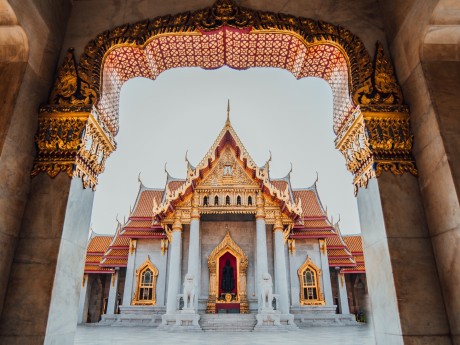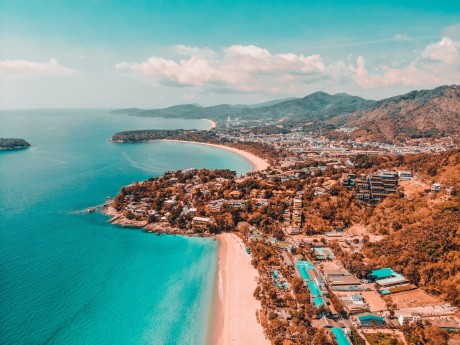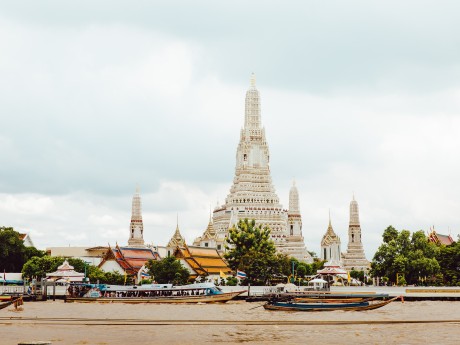Thailand: Bangkok & Phuket
Embark on a thrilling adventure to Thailand's bustling metropolis and coastal city. In Bangkok, visit the glittering Grand Palace and see the revered Emerald Buddha. A day trip to Pattaya will be a chance to indulge in a variety of water sports. Visit the iconic Big Buddha when in Phuket. Explore the iconic temples, towering skyscrapers and take a stroll through the bustling Chatuchak Weekend Market to taste delicious street food as you soak up the lively atmosphere while staying in Bangkok.
Read more
Embark on a thrilling adventure to Thailand's bustling metropolis and coastal city. In Bangkok, visit the glittering Grand Palace and see the revered Emerald Buddha. A day trip to Pattaya will be a chance to indulge in a variety of water sports. Visit the iconic Big Buddha when in Phuket. Explore the iconic temples, towering skyscrapers and take a stroll through the bustling Chatuchak Weekend Market to taste delicious street food as you soak up the lively atmosphere while staying in Bangkok. Relax on the picturesque Pattaya Beach, only a short ride away. In the tropical paradise of Phuket, you will find some of the world's most beautiful beaches. Wander around the vibrant streets of Phuket Town, where you'll discover a rich blend of Thai, Chinese, and European cultures. Don't miss the opportunity to take a boat ride to the stunning Phi Phi Islands, known for their turquoise waters and towering limestone cliffs. Waterviews offers hotels within walking distance to water and optional activities via our “Add Activities’’ button in our booking page. All Prices include taxes and Hotel charges are on a per room basis. To customize this trip to your personal preferences, contact us at: Service@waterviewstravel.com**
Destinations
- Bangkok
- Phuket
Itinerary
Bangkok

Whatever you're looking for in a city, Bangkok has it all. Visitors of all tastes and cultures will find something in Thailand's biggest city to suit their style - from cultural highlights such as the historic Grand Palace to wild evenings in the brightly lit city centre, Bangkok is not easily forgotten. It's also a city that truly rewards travellers who simply wander and explore. With nearly 12 million inhabitants, Bangkok is the economic, fashion, luxury and, of course, the entertainment heart of Southeast Asia.
Read more
Whatever you're looking for in a city, Bangkok has it all. Visitors of all tastes and cultures will find something in Thailand's biggest city to suit their style - from cultural highlights such as the historic Grand Palace to wild evenings in the brightly lit city centre, Bangkok is not easily forgotten. It's also a city that truly rewards travellers who simply wander and explore. With nearly 12 million inhabitants, Bangkok is the economic, fashion, luxury and, of course, the entertainment heart of Southeast Asia.
Additional Information
Just under 14 degrees north of the equator, Bangkok is a tropical metropolis that is also one of the most traveller-friendly cities in Asia. A furious assault on the senses, visitors are immediately confronted by the heat, the pollution, unpleasant smells, and the irrepressible smile worn by many Thais. Despite the sensationalised international news reports and first impressions, the city is surprisingly safe (except for petty crimes) and more organised than it initially appears, and is full of hidden gems waiting to be discovered. The high relative humidity and warm temperature favour the growth of tropical plants — you'll find exotic orchids and delicious fruit everywhere. Bougainvillea and frangipani bloom practically all over the city. Thai cuisine is justifiably famous, varied, and affordable. Bangkok for many represents the quintessential Asian capital. Saffron-robed monks, garish neon signs, graceful Thai architecture, spicy dishes, colourful markets, traffic jams, and the tropical climate come together in a happy coincidence. It is difficult to leave with only lukewarm impressions of the city.
History
"Bangkok" was originally a small village on the west bank of the Chao Phraya River. After the fall of Ayutthaya in the late 18th century, King Taksin the Great turned that village into Siam's new capital and renamed it Thonburi. In 1782, King Rama I moved the capital to the eastern bank of the river at Rattanakosin; originally the site of a Chinese community, which was moved outside of the new city walls to Yaowarat. King Rama I named the city Krung Thep, as it is now known to Thais and which in English translates as the "City of Angels".
The full name "Krung thep mahanakhon amorn ratanakosin mahintharayutthaya mahadilok popnoparat ratchathani burirom udomratchanivetmahasathan amornpiman avatarnsathit sakkathattiyavisnukarmprasit" (กรุงเทพมหานคร อมรรัตนโกสินทร์ มหินทรายุธยามหาดิลกภพ นพรัตน์ราชธานี บุรีรมย์อุดมราชนิเวศน์มหาสถาน อมรพิมานอวตารสถิต สักกะทัตติยะวิษณุกรรมประสิทธิ์) is listed as the world's longest location name by the Guinness Book of Records; an English rendering goes like this: "The city of angels, the great city, the residence of the Emerald Buddha, the impregnable city of Ayutthaya of God Indra, the grand capital of the world endowed with nine precious gems, the happy city, abounding in an enormous Royal Palace that resembles the heavenly abode where reigns the reincarnated god, a city given by Indra and built by Vishnukarn". Foreigners never caught on to the change, so in foreign languages Krung Thep inherited the name Bangkok, which became its formal English name. For Thais, the name Bangkok refers to the former village on the west bank of the Chao Phraya, which was incorporated into Greater Bangkok in 1971.
Life was taking place on the water; ordinary people lived on bamboo-rafts along the river, while floating vendors roamed the water to sell fruit and vegetables. The only stone structures built on land were temples and palaces. In the 19th-century, Western powers incorporated much of Southeast Asia into their colonial empires. Kings Rama IV and V felt that the only way to keep Siam independent was to modernise the country along European lines. Traditional canals were filled up and turned into roads. King Rama V moved the residence of the King to Dusit and laid out that district's grand boulevards along European lines.
Bangkok really started to develop after World War II. The economic centre shifted from the orderly planned city of Rattanakosin in an eastward direction, leaving Bangkok without an obvious centre. Bangkok established itself as the driving power behind Thailand's new role as a newly industrializing country from the 1980s onwards. Rapid economic growth has attracted migration from the countryside, with millions of Thais moving here from Isaan and other regions to make a living. As Thailand has grown into the main economic centre of the region, in modern times, Bangkok has also attracted many migrant workers from neighbouring Myanmar, Laos and Cambodia.
This rapid expansion turned Bangkok into one of the most cosmopolitan and happening cities in Asia; but also ensured numerous problems. A wide gap has emerged between those who profit from economic activity, and those who came to the city from the countryside in search of work. Bangkok's seemingly never-ending traffic jams continue as the new Skytrain and MRT systems are too expensive for the working class. Getting a break from the fumes in a park would seem to be a good idea, but unfortunately Bangkok has the lowest amount of green space of all capital cities in the world.
Addresses and navigation
Addresses in Bangkok use the Thai addressing system, which may be a little confusing to the uninitiated. Large roads such as Silom or Sukhumvit are thanon (ถนน), often abbreviated Th or glossed "Road", while the side streets branching off from them are called soi (ซอย). Sois are numbered, with even numbers on one side and odd numbers on the other side. Thus, an address like "25 Sukhumvit Soi 3" means house/building number 25 on the 3rd soi of Sukhumvit Road. While the soi numbers on each side will always advance upward, the numbers often do not advance evenly between sides — for example, Soi 55 could be across from Soi 36. Many well-known sois have an additional name, which can be used instead of the number. Sukhumvit Soi 3 is also known as "Soi Nana Nuea", so the address above might thus also be expressed as "25 Soi Nana Nuea". The extension /x is used for new streets created between existing streets, as seen in Sukhumvit's soi pattern 7, 7/1, 7/2, 9, 11. Some short alleys are called trok (ตรอก) instead of soi.
To make things a little more complex, some large sois like Soi Ekkamai (Sukhumvit Soi 63) and Soi Ari (Phahonyothin Soi 7) have their own sois. In these cases, an address like "Ari Soi 3" means "the 3rd soi off Soi Ari", and you may even spot addresses like "68/2 Ekkamai Soi 4, Sukhumvit Road", meaning "2nd house beside house 68, in the 4th soi of Ekkamai, which is the 63rd soi of Sukhumvit". In many sois, the house numbers are not simply increasing, but may spread around.
To further bewilder the tourist who doesn't read Thai, the renderings of Thai street names in the Latin alphabet are not consistent. The road running towards Don Mueang Airport from Victory Monument may be spelled Phahonyothin or Phahon Yothin or Pahon Yothin or Phaholyothin depending on which street sign or map you consult. It's all the same in Thai, of course, only the romanisation varies.
And if that's not confusing enough, most of the larger streets tend to change names altogether every few kilometres. Sukhumvit is called Sukhumvit on one side of the tollway (roughly east), but it becomes Phloen Chit just before you cross Witthayu Road (aka Wireless Road) going towards the river. Keep going just a few more streets and it becomes Rama I Road (or Phra Ram Neung Road) after you pass Ratchadamri Road. But if you were to turn right onto Ratchadamri, in just a few blocks you'll find yourself on Ratchaprarop Road (past Phetchaburi, aka New Phetburi, which is called Phitsanulok closer to the river).
Fortunately, there's logic to these name changes: most of them are neighbourhoods. It wouldn't make sense to call the road Sukhumvit if it's no longer running through the Sukhumvit area, would it? Thus, Sukhumvit becomes Phloen Chit where it runs through the Phloen Chit area. It's when you're able to grasp the city in terms of its neighbourhoods that it both becomes more navigable and more charming. Likewise, Pratunam and Chatuchak are much more than just markets; they're neighbourhoods, each with their own distinct character.
Compass directions are not widely used by Thais to navigate in Bangkok. Thus, asking for directions in terms of "Is that west from here?" will probably earn you little more than a confused look from a local. You're better off to familiarise yourself with the neighbourhoods and navigate to and from them. "How do I get to Thong Lo?" will get you there faster than asking for directions to Sukhumvit Soi 55.
One exception: the Chao Phraya River is the landmark in Bangkok, and many directional references can be made as "toward the river" or "away from the river". If you aren't too close, that is: since the river winds around the most popular tourist areas, river references tend to be most helpful when you're wandering farther afield than Khao San Road, Sanam Luang or Rattanakosin. And wander you should.
Climate
According to the World Meteorological Organization, Bangkok is the world's hottest city. Just 14 degrees north of the equator, Bangkok is sunny at all times of the year with temperatures over 30°C (86°F).
The most pleasant time to visit is the cool season that lasts from Nov-Feb. It is both the coolest and driest period — the Emerald Buddha statue in Wat Phra Kaeo even wears a scarf during this period! Don't think that's necessary though — daytime temperatures still hover around 30°C (86°F), but it does cool down into the lower 20s as it gets dark (lower 70s in Fahrenheit), and on rare occasions can even dip as low as 15°C. March and April represent the hot season, and hot it is — 35°C (95°F) on average, but don't be surprised to see heat indices rising into the 50s °C (around 120 °F+). This is the worst season to visit Bangkok, so plan in a lot of air-conditioned shopping mall visits and get a hotel with a swimming pool. Then there's the wet season that runs from May-Oct. Expect massive downpours resulting in floods all over the city, and spells of thunder at times. It's not all bad though — the afternoon showers are actually a pleasant way to cool down from the heat, and while they may last all day, usually they're over within an hour. Extreme rainfall happens in September and October, so these months are best avoided.
Whatever season you're visiting, don't take the weather lightly — temple-tramping in the scorching afternoon sun can be a challenge, so come well-prepared. Dress lightly for the weather, but keep in mind that some palaces and temples (notably the Grand Palace) have a strict dress code, i.e., everyone must fully cover their torso, legs and upper arms. So shorts, halter tops, etc. will deny you entry. At entrances to some major attractions, vendors may rent needed coverage.
Also be sure you drink enough fluids! You have no excuse not to, as 7-Elevens and other convenience stores are abundant in Bangkok and sell cooled beverages for as little as 10 baht. Locals get their water from "reverse osmosis" purified water machines that fill up a one litre bottle for 1 baht, but the potability for visitors may vary.
Films
Foreign films were popular in Thailand from the get-go, but in the 1920s a local film industry started to emerge in Bangkok. The most critically acclaimed Thai films were produced in the "three waves" of the Thai film industry, the 1930s, the 1950s and the late 1990s/early 2000s, although films made before World War II have unfortunately been lost. Predominant genres are action, historical epics, romance and gay/transgender films, almost always intertwined with elements of comedy. The following are staged (at least partly) in Bangkok: 6ixtynin9 (เรื่องตลก 69, Pen-ek Ratanaruang, 1999). Tum, a secretary just fired from a financial corporation during the Asian financial crisis, discovers an instant noodle box in front of her door. It is filled with money and she decides to keep it. However, the people that left it there soon want it back. Bangkok Dangerous (บางกอกแดนเจอรัส เพชฌฆาตเงียบ อันตราย, The Pang Brothers, 1999). The debut of the Pang Brothers, Bangkok Dangerous is a stylish film about a hitman who finds love, and realises how his actions are hurting good people. The Beach (Danny Boyle, 2000). Richard (played by Leonardo DiCaprio) is a young American backpacker looking for adventure. In Khao San Road, he meets Daffy, who makes him believe a beach paradise exists on a secret island. It is a popular film in the backpacker community. Besides Bangkok, some scenes in this Hollywood production are filmed in Ko Phi Phi, a beach island in the south of Thailand. Citizen Dog (หมานคร, Wisit Sasanatieng, 2004). An eccentric, bright, colour-splashed film that follows the life of Pod as he moves to Bangkok from the countryside. Without a goal in life, Pod falls in love with Jin, a girl who lives for her dreams. It gives a playfully ironic portrait of Bangkok, the city that offers false dreams and real disillusionment. The Hangover Part II (Todd Phillips, 2011). American comedy film about a group of friends (the "wolf pack") who travel to Bangkok for a bachelor party. A lot of stereotypes are confirmed, but it is still a good laugh. Most scenes of the film are shot in Yaowarat, Sukhumvit and Thonburi. The State Tower in Silom is also featured. Iron Ladies (สตรีเหล็ก, Youngyooth Thongkonthun, 2000). This film follows the true story of a men's volleyball team that almost entirely consists of gay and transgender players. The team competes for the 1996 national championships, and while the crowd loves them, they are being judged by other teams and match officials. Ong-Bak: Muay Thai Warrior (องค์บาก, Prachya Pinkaew, 2003). Martial-arts star Tony Jaa's breakthrough film and an absolute must-see for those interested in Muay Thai or fight choreography. Many places in Bangkok are featured, but don't think Khao San Road is the underground fighting den as it is portrayed.
© Sourced from Wikivoyage
Phuket

As Thailand’s largest island, Phuket is renowned as one of the country’s - and Southeast Asia’s - most attractive destinations. Home to a wealth of natural beauty that includes numerous white sand beaches, turquoise blue seas and lush green rainforest, it’s not hard to see why this place has become a tourism hub of the Andaman coast. Whether you’re looking to relax, enjoy the island’s buzzing nightlife, discover its rich culture or go trekking in the jungle, you won't be disappointed with what Phuket has to offer.
Read more
As Thailand’s largest island, Phuket is renowned as one of the country’s - and Southeast Asia’s - most attractive destinations. Home to a wealth of natural beauty that includes numerous white sand beaches, turquoise blue seas and lush green rainforest, it’s not hard to see why this place has become a tourism hub of the Andaman coast. Whether you’re looking to relax, enjoy the island’s buzzing nightlife, discover its rich culture or go trekking in the jungle, you won't be disappointed with what Phuket has to offer.
Additional Information
Phuket Town is the largest town in Phuket Province. It has a population of 63,000 and is the economic hub of the island. For the most part just an ordinary, scruffy provincial Thai town, it's hardly a major tourist attraction, but the Chinatown area is worth a quick look and there are some great Thai-style shopping opportunities too. Overall, accommodation and food in the town is cheaper than near the beaches, and can provide a refreshing change of pace.
© Sourced from Wikivoyage





